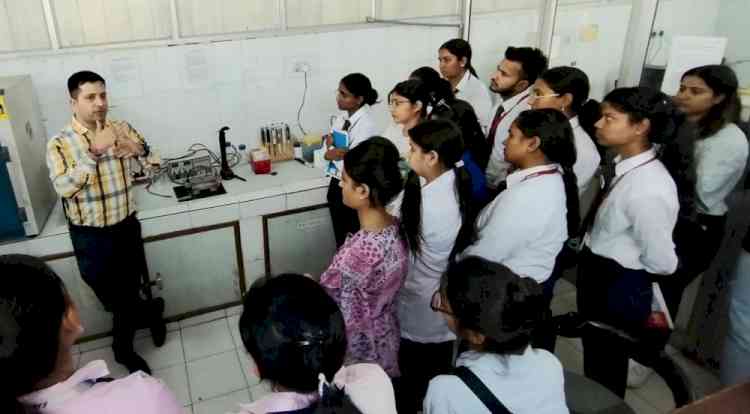PAU experts from various departments held meeting on strategies for sloving glut like situation of potato
Author(s): City Air NewsLudhiana, March 27, 2017: PAU experts from various departments held a meeting on strategies for sloving the glut like situation of potato after every couple of years and have suggested short and long term strategic...

Ludhiana, March 27, 2017: PAU experts from various departments held a meeting on strategies for sloving the glut like situation of potato after every couple of years and have suggested short and long term strategic measures:
First of all, potato consumption by the humans and the animals should be promoted through direct and indirect mode. The use of potato can be increased in homes, mid-day meals, jails, hostel messes and langars of the religious places.Further, potato flour can be used in various products like pinni, panjiri, mathi, sevia and biscuits. The developed products can be prepared by using cereal pulse mix, potato flour and green leafy vegetables. These products have been found high in energy, protein, calcium, iron and zinc and above all inexpensive. Therefore, these must be recommended for pre-school malnourished children under supplementary feeding programme run by government and non-government agencies. Potatoes can be utilized for canning purpose i.e. in the form of canned curried potato. This product has export potential. Potatoes can also be cut into cubes, blanched and frozen at -18 °C in Individual Quick Freezers (IQF). This product has shelf life of 12 months. These frozen cubes can be used in curried vegetables and in form of products like tikkis.
GADVASU has investigated that potato can be a good source of cattle feed that improves the milk yield without any adverse effect on milk composition or body weight (BW) of the animals. Similarly, feeding of 6.0 kg waste potatoes from cold storage increased the average daily gain in growing buffalo calves. Fresh cull potatoes or waste from cold storage can be ensiled to increase storage life and use as animal feed. The clean potatoes containing approximately 15-20% dry matter should be chopped along with dried hay, maize stover or straw on weight-by-weight basis in 75-82:18-25 ratio and ensile. Alternatively a blend of potatoes, dry chopped hay and ground grain in 80:16:4 ratios can also be ensiled. However,fungal infested, sprouted, sunburnt (green-coloured) potatoes should not be fed to animals.Potatoes should be washed and introduced gradually into diets with increasing amounts over a 2-3-week period. Wherein, at start feeding should be 1.5-2.5 kg/day with gradual increase to 4.5-6.5 kg/day for calves, 10-11 kg/day for yearlings and 16-18 kg/day for 500 kg cows. We should not feed potatoes higher than 30% of the DM intake or 2.5-4.0% of BW and should not exceed 10% of their BW in any case. Frozen potatoes should not be fed because animals cannot chew them and are likely to choke, while attempting to swallow them whole. Frozen potatoes should be brought to room temperature and then fed. It is possible for cattle to choke on whole potatoes, but this risk can be minimized, if the potatoes are fed from low troughs or mashed or chaffed with roughage.
Long term approaches: Punjab is known for virus free seed potato production by having a window of low aphid period due to its geographic location. This area has a great potential to harness, as there is a huge gap between seed availability and demand of the country. In India, area under potato is 2.0 million ha, which requires 1.5 million ton of seed potato @ of 25% seed replacement and 3.0 ton/ha seed rate. Thus, 60% (1.5 million ton) of the current state potato production (2.5 million ton) can be supplied to the seed deficit states like Maharashtra, Karnataka, West Bengal, Orrisa, Gujrat and NEH region. Approximately, 3.0 lac ton is the domestic seed potato requirement of the state for planting 96 thousand ha area. Thus, 72% (1.8 million ton) of the total potato production of Punjab can be utilized as seed potato at national and state level. Hence, to harness this potential, a state level strategic planning is required by having:
i. Seed village concept: Since, Punjab is more suitable for seed potato production, therefore more focus is needed by introducing Seed Village concept strictly following seed certification standards with proper compliance of ‘Seed Plot Technique’. This would not only help in sustaining seed potato market, but would also help in maintaining a ‘Seed Potato State’ reputation among seed importing states and countries
ii. Regulated seed supply chain: There is no seed supply chain in more than 50% of the area under potato cultivation in the country. Thus, a regulatory body should be constituted with government control to ensure a regulated production, storage and marketing of seed potato to deficit states in the country and export to foreign countries as well.
The ware/ table potato utilization can also be enhanced by improving cold sorage, ethanol production and export. Modernisations of existing potato cold stores with add on capacity for CIPC based stores. Based on NCCD report endorsed by the Director, Horticulture, Punjab, new potato based cold stores are not permitted in the state for financial support. However, the present cold stores can be upgraded/modernized with add on chamber for CIPC (Chlorophenyle Isopropyl Carbamate) treated potatoes. CIPC is a sprout inhibitor and does not have any deleterious effect on processing quality of potato. In such stores, potatoes are packed in plastic netted bags and stored at (10°C ± 1). The first fogging with CIPC (40 ml/ton) is done after 2 weeks of cold storage or when small chitting (initiation of sprouting) appeared with repeat application after 60 days using DYNA fogging machine. This technology has been commercially adopted by cold store owners of Punjab and adjoining states for storage of ware potatoes. At present, the cold storage industry is deregulated, which may also be regulated by the State Government.
Ethanol/ Alcohol production can be promoted of cold stored potatoes.In cold storage, the produce is held at 4-5°C, but at this temperature starch continuouslyconverted to sugars and becomes sweet, rendering it unfit for processing into chips, flakes etc. However, the sweetness of potato makes it an ideal substrate for fermentation into ethanol as vodka and beer.
Export of potato to other Asian country can also be helpful in tackling the glut like situation in the country.It has been observed that there is a significant decline (57%) in the export of potatoes to Sri Lanka, Nepal, Pakistan and UAE in 2015-16 as compare to 2014-15. It may be strengthened by giving freight subsidy to the exporters.
Currently, the Government efforts to improve transparency in cash transactions also have partly influenced the domestic potato trade, particularly unregulated seed export from Punjab to other states. Increased production, decreased foreign export and slowed down unorganized domestic potato trade led to a glut like situation in the state. Since potato is a perishable commodity, thus essentially demands strategic planning for immediate consumption, storage, seed production, value addition and export need to avoid glut.

 cityairnews
cityairnews 
















